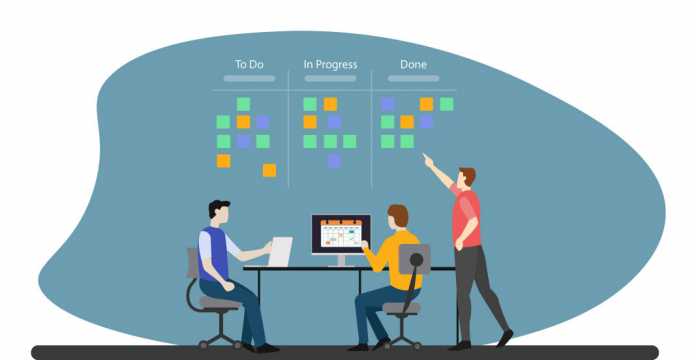
Scrum, the most common Agile software development methodology, is an iterative approach that has the Sprint — the scrum word for iteration — at its heart. Throughout an Agile project, Scrum teams use evaluation to ensure the team meets the objectives of each step of the procedure. In this article, let us answer the question, “How does agile sprint planning work?”.
The scrum approach entails gathering the specifications of the project and using them for project specifications. Then you schedule the sprints you need and split each Sprint into its own set of needs. Daily scrum sessions improve as frequent checks and evaluations keep the project on track. You control a sprint retrospective at the end of each Sprint to look at opportunities to build on the next Sprint.
What Is Scrum?
In the Agile Scrum background, much of this is assigned to the Scrum software development team, instead of offering accurate, thorough descriptions of how it is to be executed on a project. This is so the team would be properly placed to decide how to solve the challenge they have.
For instance, in Scrum development, a sprint preparation meeting is described in expressions of the intended outcome a commitment to a compilation of features to be achieved in the following Sprint, preferably than a list of Entry requirements, Role Specifications, Confirmation Requirements, Exit Criteria (ETVX) and so on, as most methodologies will offer.
Scrum focuses on an inter-functional, self-organizing unit. The scrum team is self-formation in that there is no overarching team boss who determines who will be doing what job, or how to solve a dilemma. There are problems that the team as a whole agrees on. And a team is cross-functional in Scrum, indicating that everyone has to take functionality from concept to execution.
Inside Agile growth, two central positions assist Scrum teams. The front is a ScrumMaster, who can be thought of as a squad leader, encouraging team members to compete at the highest level through the Scrum method. The other position is the product owner, and in the production of Scrum software, it represents the company, consumers, or users and directs the team towards the creation of the correct product.
What Is A Sprint In The Agile Approach?
How is it that you perceive an Agile sprint? The concept of an Agile sprint is straightforward, unlike other areas of the system loving the occasional argument, like “Sprint Zero.” The Scrum Guide defines a Sprint as “the heart of Scrum,” and it is one of the central Scrum system practices. It is the cornerstone of the Scrum system since time-bound sprint sessions are the only times in which a substance will theoretically be made usable intervals.
It was during a sprint to complete a negotiated scope of work. This means that when one Sprint is completed, another starts before the whole consumer package has been created to meet the needs of the clients.
Now let’s focus on what is agile sprint planning & its advantages.
What Is Agile Sprint Planning & Its Benefits
Any Agile Sprint plan must begin with a Sprint preparation meeting when designing applications inside an Agile project. Planning the Sprint should be the primary aim of the conference. Make sure all members of the team, such as the Scrum Master, the Scrum Production Team, and the Product Owner, are present. This meeting gives the Scrum Team a significant opportunity to focus on the amount and scale of job items that should be used in the upcoming Sprint.
Sprints are typically short-lived, ranging from around 8 hours to 1 month, and are split into two parts: Target Description and Task Estimate.
Objective Description happens during the first half of the preparation meeting where the project owner provides the Marketing Team with the specifics of the full demand customer experiences in the software backlog prioritized. The Scrum Team provides a simple description of the goal(s) for that particular Sprint in collaboration with the product owner.
Task Estimation is conducted during the second half of the session where the Scrum Production Team can come to a consensus on the approach used to complete the selected Product Backlog functionality and guarantee that the Sprint target is achieved.
If the Sprint preparation meeting continues, the accepted User Stories are being addressed, which have already been calculated and committed. Both members of the Scrum Team generate individual succinct forecasts for the job activities through methods like poker preparation. Suppose these take longer than planned, then it reveals that the user stories were not completely ready to be worked on. Each member of the Scrum Team can also use the Initiative Approximate Task List to pick the tasks they expect to focus on during the Sprint, based on their abilities and experience.
The team then makes a consensus about the amount of work to be done in the current Sprint until the Scrum Committee, led by the owner of the software, uses the Customer Stories and the commitment figures created during the Sprint Planning Meeting to build the Sprint Backlog and Sprint Burndown Map.
At the preparation meeting, the Scrum team should try not to carry out the following tasks. Both are supposed to be performed in order to train the team for the sprint conference.
Grooming – This allows the team to make confident that the specifications and user Stories are done before the preparation meeting begins, and ensure that the team has a fully assessed and consistent range of Stories that can be broken down into assignments without difficulties and then measured.
Updates or Updates – This step could require changes to original assessments of User Story assisted by the mission formation and intricacy variables addressed during the Sprint Preparation conference.
Basically, the team should carry out these activities before the start of the meeting, as they would contribute to more preparation and mitigate the loss of time. That’s it, folks! I hope you found this article on how agile sprint work interesting.
To learn more about various Agile methodologies like Scrum and Sprint, one should consider pursuing popular Agile certification courses from an Accredited Training Organization.
Some of the popular Agile Certification Courses that individuals and enterprise teams can take up are:
















